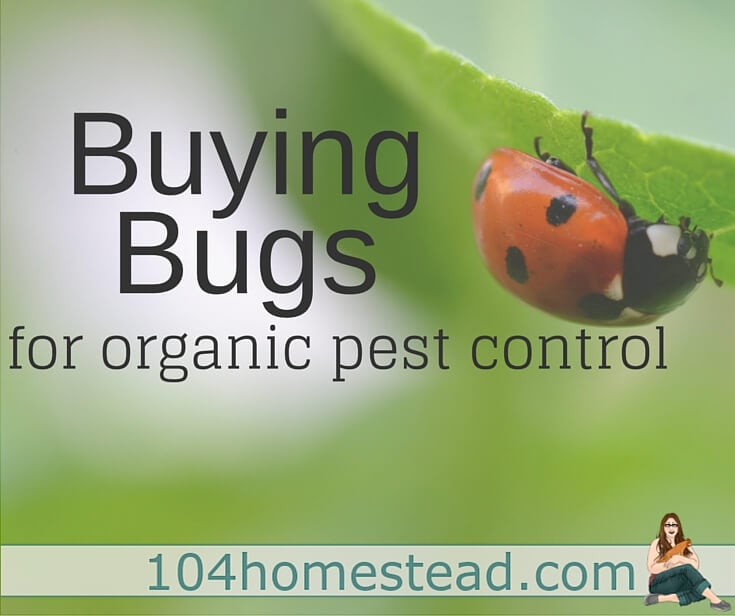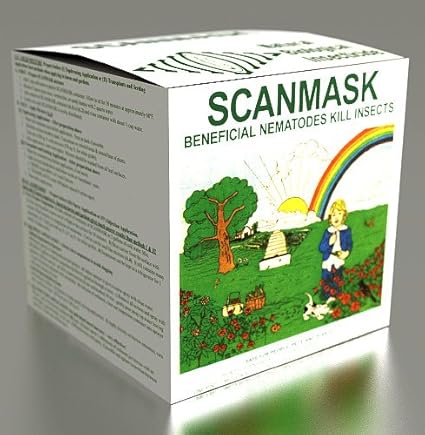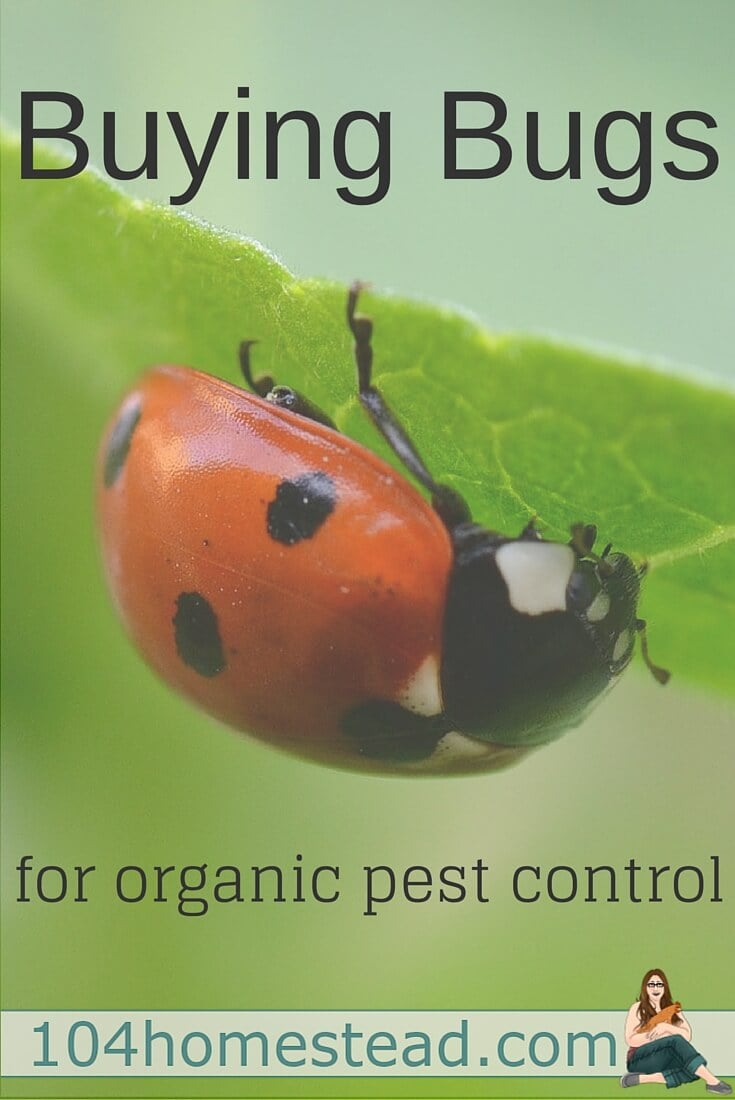Organic Pest Control {Buying Beneficial Bugs}
One of the best organic pest control techniques involves making your property an ideal environment for beneficial bugs. You can start by creating a pollinator-friendly garden. Many pollinator gardens contain plants that attract other “good guys” to your area. You want three types of good guys in your garden.

The first is the pollinators. They won’t do much for pest control since many are gentle giants, but they do promote the success of your food crops. The second is the predators. These are the ones that take care of all the troublesome bugs. The third is the parasites. Yes, some parasites are good. These guys take care of pests by using the bad guys as an incubator for their young. Having all three will help you build a natural system of organic pest control.
Making Your Yard Home to Beneficial Bugs
The first place to start when you want beneficial bugs to come home to your yard is to stop killing them. Yeah, even those organic pesticides and organic pest control methods kill good guys. If you sprinkle or spray, chances are the good are going away with the bad. Resist the temptation to use pesticides unless the pests have taken over. Even then, organic is best and less is more.
The second thing you’ll want to do is set the mood for the beneficial bugs with a wide variety of native plants. Having an eco-friendly yard involves planting these native plants throughout your property. You’ll also want to provide hiding spaces and homes for the creepy crawlies. Examples include logs and piles of rocks. With a creative eye, you can make these things look ornamental in the yard.
Just doing these two things will increase the odds of beneficial bugs moving in and staying around. Sometimes you need to get a “family” of bugs established and treat them well from that point on.
Buying Beneficial Bugs for Organic Pest Control
Did you know you can buy bugs? It’s true! I was beyond thrilled when I stumbled upon them on Amazon (don’t worry, I’ll link to the goodies below). Of course, I had flashbacks of history when I first found out you could order bugs online. Lobate Lac Scale and Croton Scale came to Florida via ornamental plants from other countries. Once they hit the wild, they started taking out native trees at an astounding rate. The Red Bay Ambrosia Beetle somehow found its way into Georgia. They cultivate a fungus that kills a native fungus that is the primary food for two varieties of Swallowtail butterflies. We know
The Red Bay Ambrosia Beetle somehow found its way into Georgia. They cultivate a fungus that kills a native fungus that is the primary food for two varieties of Swallowtail butterflies. We know how important butterflies are. Even now, Colorado is looking to import and release wasps from China to control Emerald Ash Borer Beetles. What could possibly go wrong? Let me count the ways…
The beneficial bugs we are going to talk about today are native to all parts of the US. An increase of their populations in your area will not throw off nature’s balance. Okay, maybe that isn’t 100% true. If you live on a small lot and you order 10,000 lacewings, there might be a few issues, but most likely they’d die off from lack of food. So, on to the bugs…
Green Lacewings

Green Lacewing larvae are very active and can kill up to six hundred aphids while in their larval stage, which lasts from two to four weeks. The larvae are a natural enemy of aphids but also feed on other garden pests including spider mites, thrips, whiteflies, eggs of leafhoppers, moths, leaf miners, small caterpillars, beetle larvae, and the tobacco budworm. The only drawback is that they can bite. Thankfully they are nocturnal and tend to stay close to their food source, so unless you make a habit of wandering your garden late at night, you should be hunky-dory.
If it is early spring and the pests have yet to arrive, ordering eggs are certainly the most economical way to buy. You’ll want approximately 1,000 eggs for every 500 square feet of garden. If the gardening season is well underway, larvae or adults would be another option. Larvae go right to work immediately, but adults will begin laying eggs immediately, which might be more cost effective in the long run. Purchase Green Lacewing Eggs
Ladybugs

Ladybugs and Lady Beetles are not the same things. Lady Beetles come from Asia and are not native. Ladybugs are general predators that feed on a variety of slow-moving insects including aphids, moth eggs, mites, scales, thrips, leafhoppers, mealybugs, chinch bugs, asparagus beetle larvae, whitefly, and other slow-moving insects. They are a must-have for organic pest control.
You will need approximately 8,000 Ladybugs for every 500 square feet of garden. Ladybugs are one of the most cost-effective beneficial bugs to purchase for the garden. Purchase Live Ladybugs
Mason Bees

These guys aren’t going to provide organic pest control, but they will help your gardens grow. These are friendly bees that won’t bother people in the slightest. Houses are available and if you’re lucky, some local Mason Bees might move in. If they don’t, Mason Bees are also available for purchase.
Mason Bees are only shipped during the winter months (November thru March) when they are dormant. Purchase East Coast Mason Bees (Osmia lignaria lignaria) or Purchase West Coast Mason Bees (Osmia lignaria propinqua) See more about buying Mason Bees responsibly.
Parasitic Nematodes

Parasitic Nematodes are microscopic organisms that live underground. They will seek out and destroy a wide variety of soil-dwelling and wood-boring insects including Japanese beetles, cut worms, wire worms, weevils, white grubs, fungus gnat larvae, flea larvae, and subterranean termites. They enter the body cavities of bad bugs and release bacteria that kill the pest. They are completely safe for people, pets, and the environment.
Since these guys are so tiny, you’ll need a lot of them to get the job done. You will want to purchase approximately 6,500,000-17,500,000 per 500 square feet of garden depending on the pests you are trying to get rid of. Purchase Parasitic Nematodes
Praying Mantis

Praying Mantis is the most aggressive of the beneficial bugs. If you are buying your bugs online, order only Praying Mantis and no other (as the Praying Mantis will eat any others). The major reason to consider Praying Mantis is that they tend to stay put and they are hardy in the most extreme conditions.
Praying Mantis are sold in egg cases. You will need approximately 1 egg case per 500 square feet of garden space. It is best to purchase these guys in the early spring so they have a chance to hatch and reach adulthood before the end of the season. Purchase Praying Mantis Eggs
Local Is Better
Of course, getting local bugs to come to you is obviously the best way to go. Check with gardening friends to see if they have some of these beneficial bugs hanging around their homes. If they do, maybe they will offer you some to get you started. Happy organic gardening!

